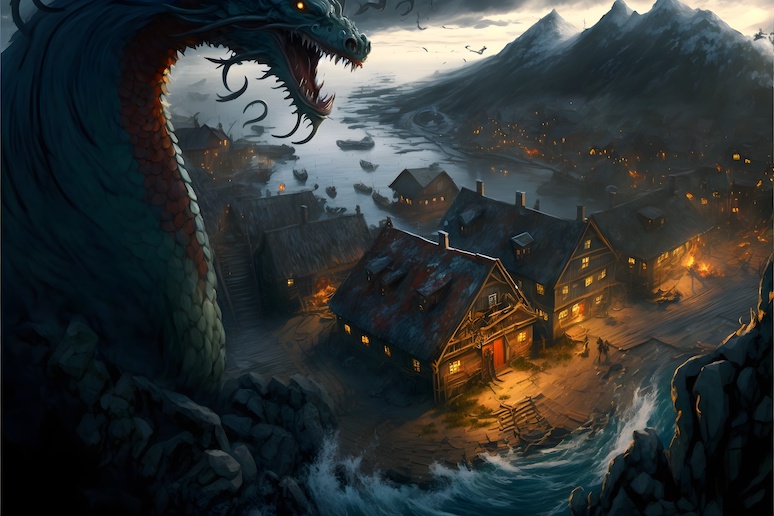Ever heard of a Jötunn, or a Norse giant?

A Jötunn is a huge, mythical creature that has captivated the minds of storytellers and scholars alike. But what are these extraordinary creatures and what role do they play in Nordic lore?
In this post, we will delve into the idea of a Jötunn, or giant, uncovering the important role it plays in Norse mythology.
What does “Jötunn” mean?
The word “Jötunn” refers to a powerful giant, usually living on the edges of a divine domain.
These giants – collectively known as “Jötnar” – embody both raw chaos and the essential forces of nature.
Whilst “Jötunn” is often translated as “giant”, this only begins to scratch the surface of the multifaceted nature that these entities embody. Just as their name holds a deeper significance, so too do the Jötnar themselves.
Where does the idea of Jötunn come from?
The concept of a Jötunn finds its origins in Norse mythology, where giants play a significant role in the tales of gods and heroes.
Unlike conventional giants, the Jötnar are not just oversized humans. Instead, they embody the natural forces themselves. Picture them as living representations of mighty natural phenomena such as mountains, storms and seas.
These massive beings play an essential role in the epic narrative, and their interactions with the gods shape the destiny of mortals and deities alike.
So, as well as being a big, mythical beast, a Jötunn personifies the untamed forces that govern the universe.
Hold up, how do you pronounce “Jötunn”?
The word “Jötunn” is pronounced “Yœ-toon“. The “j” is pronounced like the “y” in “yes”.
The word comes from Old Norse, an ancient language spoken by the Norse people of Scandinavia. In Old English, the word is “oeten”.
So, is a Jötunn the same as a troll?
While both Jötnar and trolls are prominent figures in Norse folklore, they are not quite the same. The term “Jötunn” is used to refer to a variety of giant-like beings, while a troll is just one of a specific type of Jötunn.

Think about it like this: a Jötunn can be a troll, but a troll isn’t necessarily always a Jötunn.
As for whether Norse giants were actually “giants”, it’s essential to understand that their description goes beyond mere size.
Some Jötnar possess shape-shifting abilities, allowing them to change their appearance at will. This unique trait further separates them from traditional giants.
Jötnar may also wield magical skills, allowing them to manipulate the elements and influence events in the mythological realm. As far as their strength goes, that extends far beyond that of a simple oversized human.
So, while the term “giant” may describe the physical stature of a Jötunn, it merely hints at the profound depths of their true essence,
Where are the Jötnar from?
According to Norse legend, Jötnar primarily hail from the realm of Jotunheim. But they’re not just limited to that land.

Fire giants also emerge from the fiery domain of Muspelheim, a realm of flames, showing that jötnar have a diverse presence.
Beyond those two realms, the presence of Jötnar extend throughout the realms of the Norse mythology universe.
Just how big is a Jötunn?
The size of a Jötunn varies greatly, but some reach truly gigantic proportions. Among them, Ymir stands as a prime example.
According to the ancient texts, Ymir was the first Jötunn, created from the ice of Niflheim and the heat of Muspelheim.
This ancient giant was so immense that he created the entire world from his body, forming the seas from his blood, the earth from his flesh, and the sky from his skull.
Another remarkable example is Skrymir, whose size was so staggering that he was mistaken for a mountain by the thunder god, Thor.
The giant’s glove alone was mistaken for a sleeping shelter, further emphasizing his awe-inspiring scale.
While not all Jötnar reached such a monumental size, these examples showcase the proportions some giants could attain.
How long do these Norse giants live?
In Norse mythology, the lifespan of a Jötunn can vary widely, much like their size and characteristics. Some giants are said to live for extended periods, while others are subject to the same mortal limits as humans.

According to the myths, Ymir existed before the creation of the world and lived for an exceptionally long time, potentially spanning eons.
On the other hand, not all the Jötnar were blessed with such a long lifespan.
For instance, Thrym, the frost giant who stole Thor’s hammer, Mjölnir, was eventually killed by Thor in his quest to retrieve his stolen hammer.
Giants from Norse mythology (and their powers!)
And, of course, each jötunn has different powers and characteristics. Here are some of the main Jötnar, and what they are known for.
Skrymir
Skrymir, a formidable Jötunn in Norse mythology, is renowned for his enormous size and mastery of magic, enabling him to withstand Thor’s blows and cast illusions.
In the medieval chronicle Gesta Danorum, Skrymir appears as a bound giant with an imposing size and a distinct, less-than-pleasant odour.
His true power, however, remains shrouded, as it wasn’t fully showcased during Ragnarok, the apocalyptic battle.
Fenrir
Fenrir, a monstrous wolf-looking offspring of Loki, was predicted to be a harbinger of trouble in Norse mythology.
Despite the Aesir’s attempts to contain his menacing power, Fenrir’s relentless growth and strength became a cause for concern.
During Ragnarok, the fearsome wolf ultimately fulfilled the prophecy, breaking free of its bonds and devouring Odin, the All-Father and chief deity of the Norse pantheon.
Jormungandr
Jormungandr, another of Loki’s monstrous offspring, is a colossal serpent of such immense size that it can encircle the world and grasp its tail in its mouth.

In one encounter, Thor attempts to lift the serpent, who is disguised as a cat, as he fails to realize Jormungandr’s true form.
The ultimate showdown between Thor and Jormungandr takes place during Ragnarok. Although Thor manages to defeat the serpent, he falls victim to its venomous bite, succumbing to the deadly poison shortly afterwards.
Thrym
Thrym, a mischievous Jötunn, is infamous for his audacious act of stealing Thor’s mighty hammer, Mjölnir.
He demands the hand of Freyja, the goddess of love and beauty, as his bride in exchange for returning the powerful weapon.
This daring theft leads to a comical and unforgettable myth in which Thor devises a plan to retrieve Mjölnir. Donning a bridal gown and masquerading as Freyja, Thor engages in a charade that culminates in the recovery of his beloved hammer and Thrym’s downfall.
Utgard-Loki
Not to be confused with Loki, the trickster god, Utgard-Loki is a giant who rules over the castle Utgard in Jotunheim.
In the myths involving this crafty giant, he challenges the gods with perplexing tests and mind-bending illusions, showcasing his remarkable prowess in manipulating perception and reality.
Gerd
Gerd, a captivating giantess in Norse mythology, wins the heart of the Vanir god Freyr. Their love story holds great significance in the Norse pantheon.
Struck by Gerd’s beauty and grace, Freyr is infatuated with Gerd and yearns for her affection.
Their romance becomes a symbol of the connection between gods and giants, transcending the boundaries of their respective realms.
Hymir
Known for his incredibly thick skull, Hymir is a giant who plays a key role in the myth where Thor fishes for the world-encircling serpent, Jörmungandr.
Hymir’s role in the myth is crucial as his unyielding skull provides the foundation for Thor’s fishing expedition, where the thunder god uses an enormous ox head as bait to lure Jörmungandr from the depths of the sea.
Angrboda
A powerful giantess dwelling in the realm of Jotunheim, Angrboda is the mother of several monstrous children fathered by Loki.
Among her infamous offspring are the ferocious wolf Fenrir, the world-encircling serpent Jörmungandr, and the ruler of the underworld, Hel.
Angrboda’s lineage gives rise to a trio of mythical beings whose destinies intertwine with the fate of the gods, shaping the epic tales of the Norse cosmos.
Gunnlöð
Gunnlöð, a captivating giantess, serves as the guardian of the precious mead of poetry. This mystical mead grants poetic inspiration and wisdom to those who drink it.
In a cleverly crafted tale, Odin employs his renowned cunning to trick Gunnlöð into giving him the coveted mead.
Skaði
Skaði, a resilient giantess, underwent a remarkable transformation in Norse mythology when she married the Vanir god Njord.
By marrying a god, Skaði ascended to the status of a goddess and became an integral part of the divine pantheon.
Often linked with the cold and harshness of winter, Skaði embodies the essence of skiing and bow hunting, which reflect her connection to the wilderness.
Thiazi
Thiazi is known for his ability to transform into an eagle. In a pivotal myth, Thiazi plays a central role in the theft of the golden apples of Idun, the goddess of youth and rejuvenation. He seizes Idun, along with her precious apples, and flies away in eagle form.
Who could defeat a Jötunn?
The Jötnar held a deep-seated fear of the Aesir, the principal gods. This enmity resulted from the ancient slaying of Ymir, the primordial Jötunn, by the Aesir.
And it set the stage for the escalating conflict that led to Ragnarok, the final battle and ultimate confrontation.
The Jötnar represented forces of nature, while the Aesir embodied divine authority and order. Throughout the Norse myths, clashes between the two showcased the giants’ attempts to challenge and outwit the gods.
During Ragnarok, the fear-fuelled animosity reached its peak, resulting in the mutual destruction of gods and giants, marking the end of the world and the cyclic nature of the Norse cosmos.
What happened to the giants during Ragnarok?
During Ragnarok, the giants played a pivotal role in the battle that spelled the end of the Norse world.

The fire giants, led by the fearsome Surtr, crossed the Bifrost, the rainbow bridge that connected Asgard (the realm of the gods) to Midgard (the realm of humans).
As they set foot on the bridge, it was consumed by fire, sealing the fate of the gods and leading to widespread destruction on Midgard.
Meanwhile, the frost giants, including Jormungandr and Fenrir, wreaked havoc during Ragnarok.
Jormungandr’s ferocity and size posed a significant threat, causing catastrophic floods as it thrashed in the sea, while Fenrir unleashed its unrestrained fury, seeking to devour everything in its path.
As the battle raged, both fire and frost giants clashed with the gods, leading to a cataclysmic confrontation that resulted in mutual destruction.
The giants’ chaotic and destructive temperament culminated in the fulfillment of the prophecy, symbolizing the cyclical nature of the Norse cosmos and the inevitability of Ragnarok.
FAQs
Why do the Jötnar hate the Aesir?
The conflict between the two groups stems from differences in values, with the Aesir representing order and civilization while the Jötnar embody chaos.
When did Thor find out Loki is a Jötunn?
In most Norse myths, the specific moment when Thor discovers Loki’s Jötunn heritage is unclear.
Some versions of the story suggest that he finds out when Loki and Thor travel to Jotunheim together: others, that he never truly finds out.
Where are the Jötnar from?
The Jötnar primarily hail from Jotunheim, their ancestral realm.
How long do Jötnar live?
The lifespan of a Jötunn varies; some live for extended periods, while others are subject to mortality like gods and humans.
Why did the Jötnar fight the Aesir?
The Jötnar fought the Aesir due to longstanding animosity and rivalry between the two groups, representing untamed nature and divine authority, respectively.
What is Jötunn The Ritual?
The Ritual is a 2017 British horror film. It follows a group of friends on a hiking trip in the Scandinavian wilderness, where they encounter Moder, and confront their darkest fears to survive against the ancient evil presence.
What is Moder?
In Norse mythology, Moder is the child of Loki and the giantess Angrboda. As a deity associated with the natural world, Moder serves as a guardian and protector of the wilderness.
See also:
Norse gods, goddesses and giants
Heimdall: the Norse watchman
Finnish mythology and the Kavala









